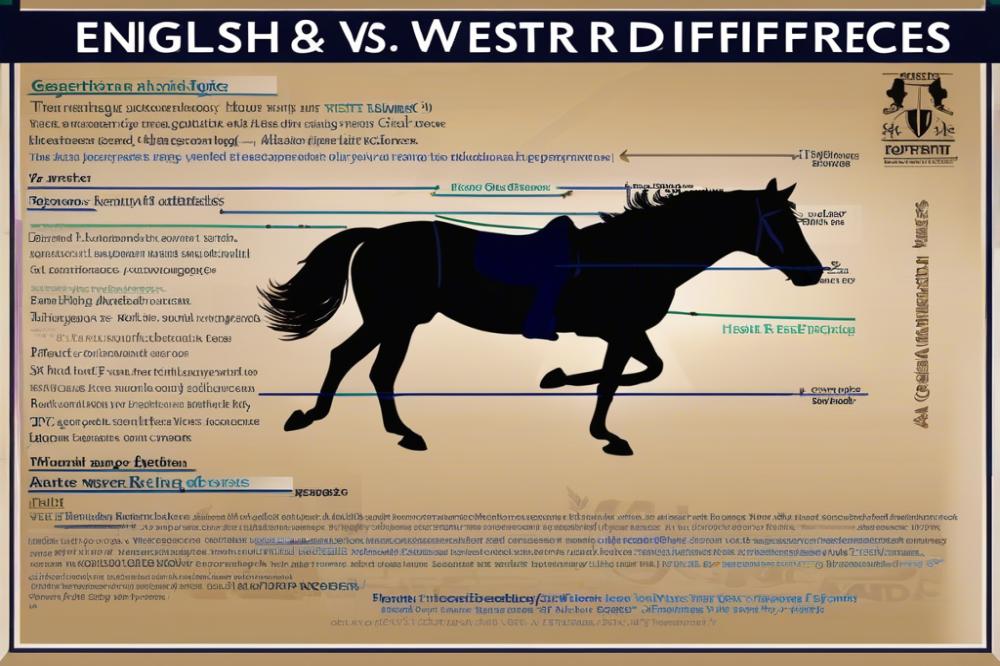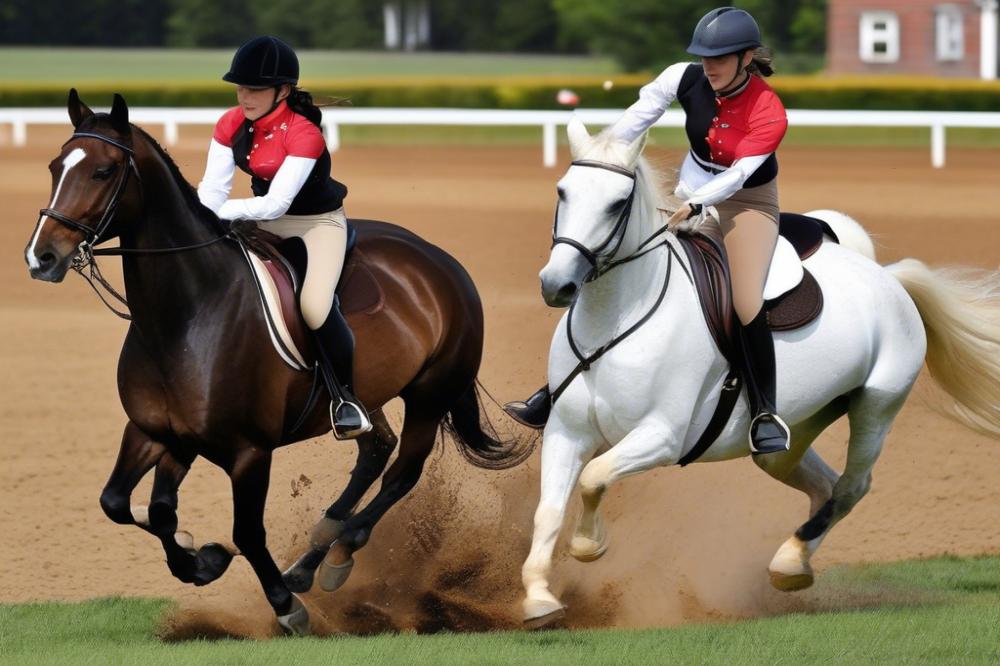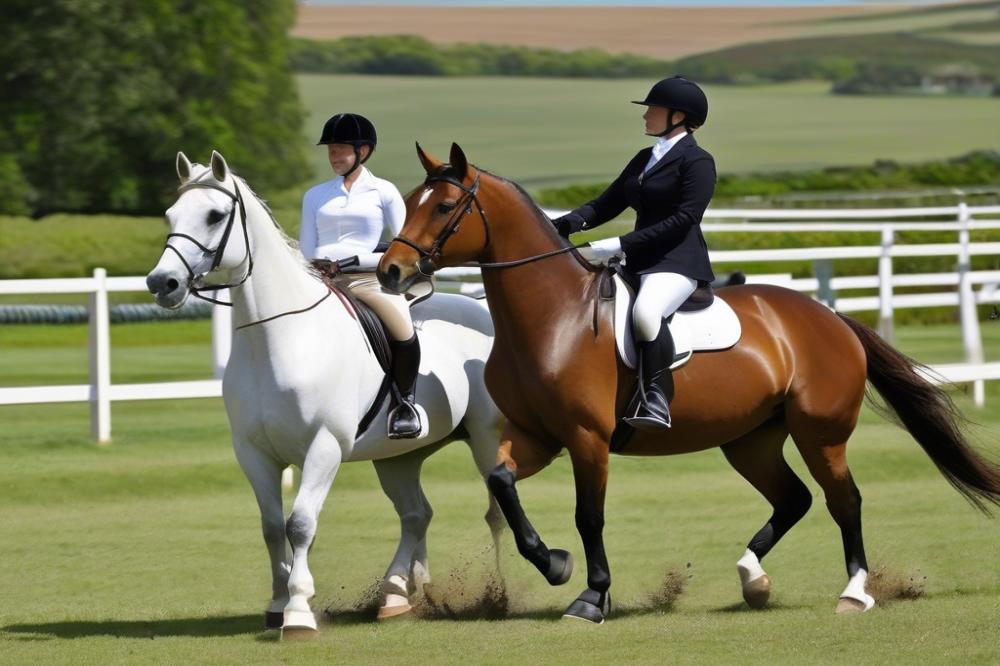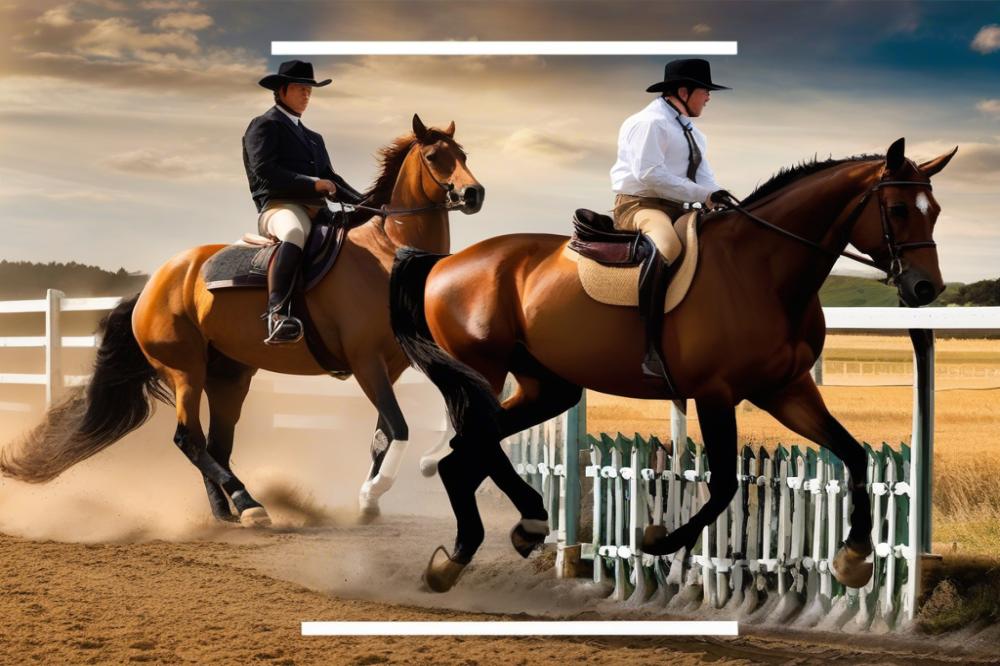Introduction
Horseback riding offers a world of excitement and connection with these magnificent animals. As riders, we often find ourselves drawn to one of the many styles available. Most enthusiasts wrestle with the question: What makes each style distinct? In the dazzling world of equestrian sports, English vs Western riding stands out with unique characteristics. Understanding these differences can greatly enhance your riding experience.
Think of it like picking your favorite pizza toppings; each choice can completely change the flavor of your experience! The same concept applies to horse riding. English riding is often associated with precision and subtlety, focusing on the fine details. Western riding, on the other hand, embraces a more relaxed, laid-back feel, emphasizing comfort and style. These varying techniques influence horse training and the relationship between rider and horse.
For those not familiar with horse riding, it might be easy to overlook the significance of these styles. Why does it matter, you ask? Well, understanding the nuances helps riders choose the right training methods and competitions. It also opens the door to tailored equestrian techniques suited to both horse and rider. Without this knowledge, one might as well try debating motorcycle vs horse – both thrilling, but certainly not interchangeable!
Newcomers often find themselves in a maze when exploring the different breeds of small horses or larger mounts. But fear not! A fair riding styles comparison sheds light on key elements that set the two apart. By recognizing these distinctions, riders can embark on their journey with confidence, ultimately elevating their time in the saddle. So whether you’re polishing your English trot or kicking back in a Western saddle, knowing where you stand can make all the difference.
History of English and Western Riding

Origins and Development of English Riding
English riding has a long and rich history. It traces back to the royalty of Europe. Knights and noblemen used these techniques for both warfare and sport. Over time, the focus shifted to elegance and competition. Events like dressage and show jumping became popular. These days, English riding is associated with many equestrian disciplines. Riders wear traditional attire, complete with a fitted jacket and tall boots. Deep-rooted traditions define this style, showcasing both skill and sophistication.
Origins and Development of Western Riding
On the other side of the coin, Western riding sprang from the needs of cowboys. The American West had vast open spaces. Cowboys needed practical riding techniques for working with cattle and navigating rough terrain. The Western saddle was designed for comfort and stability during long days on horseback. Skills like roping and barrel racing showcase the style’s practicality. Western riding has evolved into a vibrant part of equine sports, attracting many enthusiasts. Comfortable jeans and wide-brimmed hats are the typical attire for riders in this style.
Cultural Influences Shaping Each Style
Culture plays a big role in how riding styles developed. English riding reflects a history of nobility and tradition. Events like royal horse shows highlight this influence. In contrast, Western riding embodies the spirit of adventure and independence. The cowboy lifestyle has shaped not just the techniques but also the way riding is perceived. Each style has its own set of cultural values, which contribute to the ongoing riding styles comparison. While one embodies sophistication, the other celebrates freedom. Both approaches draw passionate followers who appreciate the depth of their chosen method.
Riding Equipment and Tack

Differences in Saddles and Their Designs
The saddle is one of the most important pieces of equipment for any rider. In Western riding, you’ll often see a larger, heavier saddle. It has a prominent horn at the front, ready for roping cattle or strong holds in a bend. In contrast, the English saddle is sleek and slim. This design helps riders stay closer to their horses, allowing for better connection in the various equestrian disciplines.
Riding styles comparison reveals that the Western saddle is designed for comfort and stability during long hours spent in the saddle. English saddles prioritize balance and movement. Each style is crafted with a purpose. A Western saddle usually has a lot of hardware for attaching gear. An English saddle might appear simpler but is built for performance and precision during horse training.
Bridles and Bit Variations
Bridles play a vital role in communication between horse and rider. In Western riding, you’ll often see a headstall without a noseband. This makes it easier to give signals. Bits in this style can be quite varied, with many options available like curb bits or snaffle bits. Each type has its own way of guiding the horse.
On the flip side, English bridles usually come with a noseband for extra control. You might find a flash or a drop noseband used frequently. The bits can also differ. English riders often use jointed snaffle bits that help with subtle cues. Each bit has a purpose, depending on the equestrian techniques and level of comfort for both horse and rider.
Other Essential Equipment for Both Styles
Equipment doesn’t stop at saddles and bridles. Western riders typically use larger saddle pads since their saddles are bulkier. This extra padding provides more comfort during long rides. In comparison, English riders often use fitted saddle pads. These enhance the connection and support the horse’s back.
Don’t forget about the importance of boots. Western riding boots usually have a higher heel. This design helps prevent slipping out of the stirrups. English riding boots, on the other hand, are designed low and snug. They keep the rider’s leg secure against the horse, which is important when showing.
Safety gear is also crucial. Helmets are a must in both styles. Western riders might wear cowboy hats for fun, but safety helmets protect during more intensive equine sports. Always best to keep that noggin safe! Both styles have unique elements that cater to the deft dance of horse riding, allowing for a variety of experiences in the saddle.
Riding Techniques and Styles

Posture and Body Position in English Riding
English riding demands a certain elegance. Riders sit upright with shoulders back and heels down. This position allows for a refined control of the horse. You’ll often see riders maintaining a steady leg position, using their thighs to grip the saddle. Hands hold the reins just above the withers. It’s like a delicate dance where every movement matters. Riders are encouraged to follow the horse’s motion, almost like swaying to music. Balance plays a massive role here. You’d want to stay centered and light on the horse’s back, as if you’re floating.
Posture and Body Position in Western Riding
Western riding is more relaxed, creating a sense of comfort. The seat is deeper, with a tendency to lean back slightly. Riders spread their legs, often keeping their feet flat and even resting in the stirrups. It feels casual and easy-going, much like lounging on a porch swing. The hands can be lower, allowing for a more relaxed grip on the reins. In this style, riders shift their weight more dramatically to cue the horse. It’s important to engage your core and sit solidly. Think of it as being in a sturdy chair that you can lean into.
Gaits and Movements Unique to Each Style
Each style comes with its own set of gaits. English riders often perform movements like trot and canter with agility. The posting trot is a particular favorite, where the rider rises slightly in rhythm with the horse. You’ll see this technique in equestrian disciplines like show jumping and dressage. Western riding, however, showcases the lope. This smooth, rolling gait feels more like a leisurely cruise than a sprint. It’s the kind of motion you’d want while enjoying a scenic view. Additionally, Western riding includes spins and sliding stops that make the horse look impressive. Those equestrian techniques won’t typically be seen in English riding.
In summation, each riding style offers something different. While one might focus on grace and precision, the other leans toward comfort and flair. Both styles shine in their own light in the vast world of equine sports.
Types of Riding Disciplines
Common Disciplines in English Riding
English riding boasts several popular equestrian disciplines. Dressage is one of the most elegant. Imagine a horse and rider dancing in perfect harmony. The rider guides the horse through a series of precise movements. Show jumping also captures attention. Here, horses leap over fences in a timed course. Riders need to have both skill and courage. Eventing combines dressage, jumping, and cross-country riding. It’s like a triathlon for horses, challenging both horse and rider. These disciplines showcase discipline, precision, and partnership.
Common Disciplines in Western Riding
On the other hand, Western riding has its charm. Reining is all about speed and control. Riders guide their horses through circles, spins, and sudden stops. Barrel racing is a true test of agility. Horses race around barrels in a cloverleaf pattern. When speed and skill mesh, it creates an exhilarating scene. There’s also cutting, where the horse separates a cow from the herd. Each Western discipline emphasizes quick thinking and intuition. Riders develop a natural relationship with their mounts.
How Disciplines Reflect Riding Styles
These disciplines show clear differences in riding styles. English riding often focuses on finesse and form. Riders wear fitted jackets and tall boots. They strive for a polished look, aiming for smooth transitions and precise movements. In contrast, Western riding emphasizes practicality and comfort. A cowboy hat and jeans are common attire. Riders adapt their techniques to work with their horses more fluidly. The unique approaches in both English and Western highlight traditions, techniques, and training methods. Horse riding enthusiasts can find joy in either style. Each offers its own flavor of equine sports. A riding styles comparison often reveals preferences. It’s like choosing between ice cream flavors; each has its devotees.
Horse Breeds and Selection
Breeds Typically Associated with English Riding
When thinking about English riding, certain breeds come to mind. The Thoroughbred is a classic choice. Known for their speed and agility, these horses excel in disciplines like show jumping and dressage. Another popular breed is the Warmblood, famous for their calm demeanor and strong build. They are often seen in competitive equine sports. Other breeds like the Arabian also shine in English disciplines, bringing endurance and elegance to the arena.
Breeds Typically Associated with Western Riding
Western riding often leads you to different breeds. Take the Quarter Horse, for example. They are born to sprint short distances and perform well in rodeos. Paint Horses are also common in this riding style, known not only for their striking coats but also for their versatility. Appaloosas, with their unique spotted patterns, steal the show in many western events. These horses are great for trail riding too!
Considerations for Choosing a Horse Based on Riding Style
Choosing a horse doesn’t just rely on looks. Consider what kind of riding you plan to do. If you’re leaning towards show jumping, a breed with stamina and agility can make a big difference. On the flip side, if you like rodeo events, a horse that can handle quick turns would be ideal. Experience can also play a crucial role. An experienced horse can make learning equestrian techniques smoother. Your own riding skills matter too. A spirited horse may not be the best choice for a beginner. Think about your long-term goals and interests when selecting a horse!
Competition and Events
Overview of Competitive Events in English Riding
English riding is known for its emphasis on precision and elegance. Competitions often revolve around jumping, dressage, and showing horses. Each event showcases the skills of both rider and horse. In jumping, riders navigate a challenging course filled with obstacles. Dressage involves a series of movements performed in a controlled manner, highlighting the horse’s training. Showing events focus on the horse’s appearance and the rider’s attire. Riders often wear formal jackets and helmets to present a neat image. Points are awarded based on execution and overall appearance. Many events require a high level of horse training and superb equestrian techniques.
Overview of Competitive Events in Western Riding
Western riding presents a different picture. Events such as reining and barrel racing are some of the highlights. Reining involves a set of maneuvers that test control and finesse. Riders perform spins, slides, and fast stops, showcasing their bond with the horse. Barrel racing, on the flip side, is about speed and agility. Riders race around barrels arranged in a cloverleaf pattern. It’s exciting to watch! Western events embrace a more relaxed atmosphere and often include casual attire like jeans and cowboy hats. Competitors might even wear boots that could kick up a storm!
Differences in Judging and Scoring Systems
Differences in judging and scoring make these disciplines stand apart. In English riding, judges focus on technique, elegance, and adherence to standards. Points can be deducted for faults in performance or appearance. Meanwhile, Western events often measure speed and agility. Riders earn points based on how quickly they complete a course and their horse’s responsiveness. The criteria focus less on formality and more on versatility. Most importantly, the judging styles reflect the traditions and goals of each riding style. Horse riding can take many forms, and understanding these nuances enriches your appreciation for equine sports. Isn’t it fascinating how different riding styles can transform a simple activity into a sport filled with excitement and artistry?
Wrapping Up the Ride
When we compare English and Western riding, we see distinct differences that cater to varying riders and their equine partners. English riding usually emphasizes precision and a more formal demeanor. This style often finds its home in show jumping or dressage, where horse and rider perform intricate movements. On the flip side, Western riding has its roots in cattle herding and ranch work, promoting a more relaxed posture and natural communication between horse and rider. Each style brings its flair and character, much like choosing between a tuxedo or a pair of jeans for an event.
Another noticeable difference is the equipment used. In English riding, saddles are often lighter and designed for performance, while Western saddles are bulkier but provide comfort for longer rides. Riders often find the Western saddle gives a better sense of security, much like snuggling into your favorite overstuffed chair after a long day. Meanwhile, English saddles allow for more agility, perfect for those quick turns in an arena.
The importance of finding the right style cannot be understated. Choosing between these two forms boils down to personal preferences, purposes, and, of course, the individual horse. Someone looking for a weekend trail ride may lean toward Western riding, finding joy in the leisurely adventure. Alternatively, a rider eager to compete in events might find the English style more appealing.
Considering the specific needs of both horse and rider can make a world of difference. That’s where horse handling equipment can come into play, ensuring safety and comfort for all involved. Whether you’re drawn to the calm of the countryside or the thrill of the showring, the right gear makes each ride more enjoyable.
Before you make any decisions, take a moment to reflect. Maybe you even want to try both! From ranching to riding lessons, exploring these styles opens doors to countless experiences. And hey, if you’re on the lookout for draft horses for sale near me, know that different riding styles might complement your new companion best. Remember, horses are not just four-legged friends; they’re partners in adventure!
Ultimately, no matter which style you choose, the bond between rider and horse remains the true heart of riding. Happy trails as you pick the path that suits you best!



